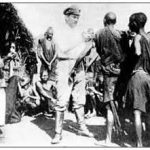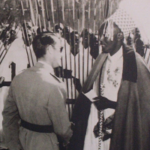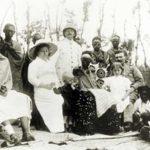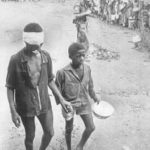From The War Years To The Abolition Of Ubuhake(1940-1954)
In 1943, a severe famine devastated many areas of Rwanda. Food shortages were less severe in Kinyaga, but Bunyambiriri and other areas to the north and east of the region were hard hit. This famine, called Ruzagayura, is remembered by Kinyagans as a time when many Rwandans from other regions moved to Kinyaga, fleeing the famine and seeking better conditions. There was also increased immigration from Bushi in the west during this period. Subchiefs apparently welcomed the new immigrants, for in the 1940s the salary of a subchief depended at least in part on the number of taxpayers under his jurisdiction. Pressure on land increased as plots were distributed to the new immigrants. One sign of increasing population pressure was the departure of significant numbers of Kinyagans toward Uvira (Zaïre) apparently in search of pasturage. During and after World War II, as the colonial administration became more efficient, compulsory cultivation of such crops as manioc, sweet potatoes, and coffee was enforced more rigorously. Akazi became more burdensome as the number of roads to build and maintain augmented, and demands for salaried workers also increased substantially. The old forms of clientship were transformed, since the principal patrons were the chiefs and subchiefs, who enjoyed a monopoly of power conditional upon the execution of demands made by Europeans. These demands they passed on to the common people, and, as we have seen, added their own exactions, which varied according to the character of the chief involved and the nature of his relationship to a particular individual. The general tendency therefore was to use power arbitrarily; in acting thus toward their relatively powerless “clients,” the patrons undermined the institution itself. During the 1940s and 1950s, young men whose fathers had submitted to clientship did their best to escape such ties, taking advantage of opportunities outside the system, and acquiring access to resources beyond the contral of local chiefs.
Efforts to abolish ubuhake cattle clientship gained momentum after World War II, reflecting the declining importance of the institution. Earlier, the colonial authorities had opposed abolition on the grounds that any such measure would undermine the authority of chiefs. But in 1951, prodded by the United Nations Trusteeship Council (particularly its Visiting Mission to Rwanda of 1948), the administration stated its intention to abolish ubuhake. And in 1952 Umwami Rudahigwa issued a circular explaining why he planned to put an end to ubuhake. Citing the increased volume of litigation in the courts between patrons and clients, he emphasized positive social and economic effects to be gained through abolition. Two years later, while the 1954 U.N. visiting Mission was in Rwanda, the king and the national Conseil Supérieur issued a decree providing for the progressive dissolution of ubuhake ties and distribution of cows to former clients.
It was politically expedient for chiefs to disassociate themselves from the stigma of identification with discredited practices.” And they may have wished to eliminate an obvious focus for potential protest, since they had acquired other and more effective means of perpetuating their dominance. The discrimination against Hutu introduced in Rwanda’s Catholic schools from the late 1920s meant that it was primarily the children of Tuutsi who attended secondary school, entered the priest-hood, worked in the administration, and benefited in myriad other ways from the system, even without ubuhake. Thus abolition of cattle clientship did not substantially threaten Tuutsi power.
The abolition of ubuhake did, however, contribute to further erosion of chiefly legitimacy. For the measure abolishing ubuhake did nothing to eliminate the exploitation characterizing the role of patrons. The patron-chiefs preserved control of land, since the edict abolishing ubuhake made no provision concerning pasturage rights for cattle ceded to former clients. Thus although clients acquired rights to private ownership over a portion of the cattle which they formerly held in usufruct, they had no means of pasturing these cattle, except through dependence on former patrons who controlled pasturage.Ubuhake land clientship was not affected by the decree. And even though the hated ubureetwa was abolished in1949, replaced by a mandatory money payment, this work for chiefs continued to be required in many areas of the country. Hutu in Kinyaga recall that they continued to perform ubureetwa services until the late 1950s.
The intense anti-chief and anti-Tuutsi sentiment generated by these institutions is reflected in a series of articles published during the late 1950s in Rwanda’s Vernacularnewspaper, Kinyamateka. Inequality of land distribution was a central issue: Several articles pointed out that the abolition of ubuhake in 1954 could hardly be effective if people still depended on chiefs for land to pasture cattle and to cultivate food or cash crops.
The abolition of ubuhake cattle clientship and ubureetwa occurred when the institutions were already under attack, and had very few defenders. On both ideological and practical grounds, some action became necessary. By 1950, the structures of Rwandan society and particularly the nature of political power had greatly altered from earlier times and therefore it was possible (officially) to abolish the most evident symbol of exploitation under Tuutsi colonialism, but to leave the essential structure of this exploitation intact. Abolishing the institution still left power in the bands of Tuutsi chiefs. Pasturage was still controlled by Tuutsi, so a person could not own cattle without coming to those with power over land on their terms. Also, the nature of political power had changed so that new forms of control had been incorporated at the very heart of the body politic in colonial Rwanda. These included control over labor, land, educational opportunities, wealth, and, most important, access to the state apparatus and to opportunities for consolidating power in the hands of a few. Class differentiation was not determined by ownership of the means of production per se, but by access to power over distribution, allocation, and accumulation. The new resources of the administrative elite far exceeded what had been available in an earlier period as a result of clientship ties. Now power was based on colonial forms of production and status, rather than on institutions such as clientship. Consequently when protest came, it was articulated in general ethnic terms or in concepts such as “demokrasi” rather than being focused on specific institutions and individuals.
https://uk.amateka.net/from-the-war-years-to-the-abolition-of-ubuhake1940-1954/https://uk.amateka.net/wp-content/uploads/2020/08/abolition_ubuhake.pnghttps://uk.amateka.net/wp-content/uploads/2020/08/abolition_ubuhake-150x150.pngChanges and ColonialismIn 1943, a severe famine devastated many areas of Rwanda. Food shortages were less severe in Kinyaga, but Bunyambiriri and other areas to the north and east of the region were hard hit. This famine, called Ruzagayura, is remembered by Kinyagans as a time when many Rwandans from other...BarataBarata rpierre@ikaze.netAdministratorAMATEKA | HISTORY OF RWANDA




